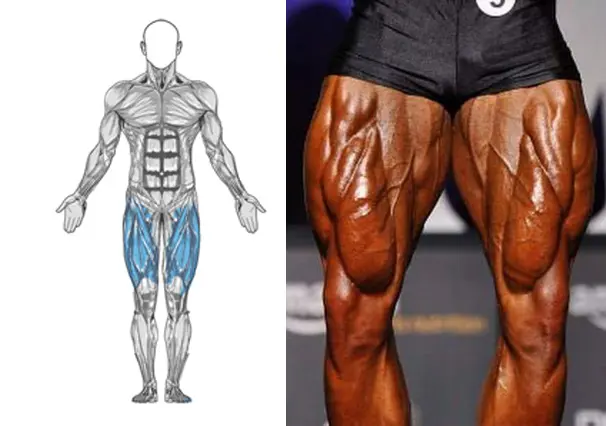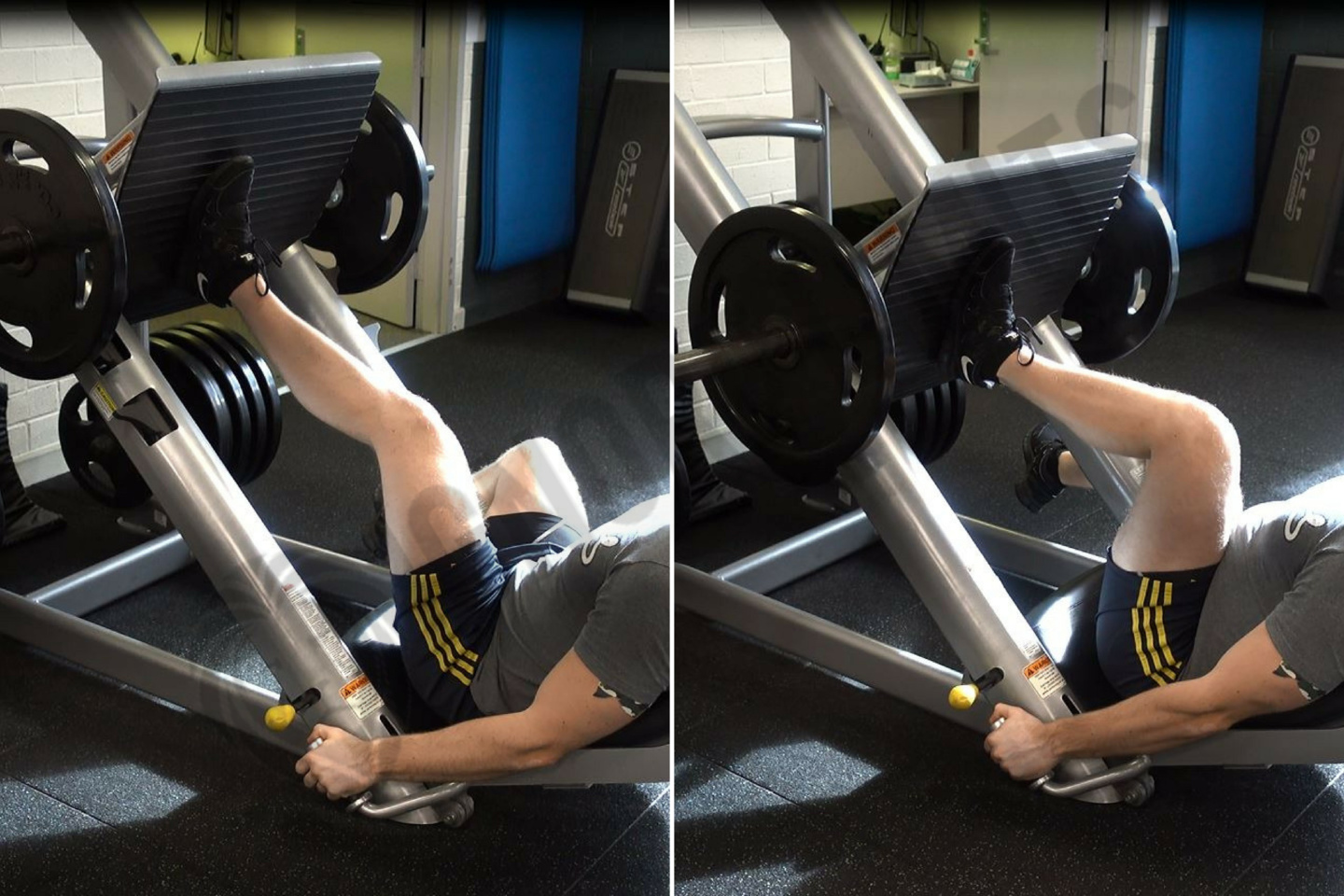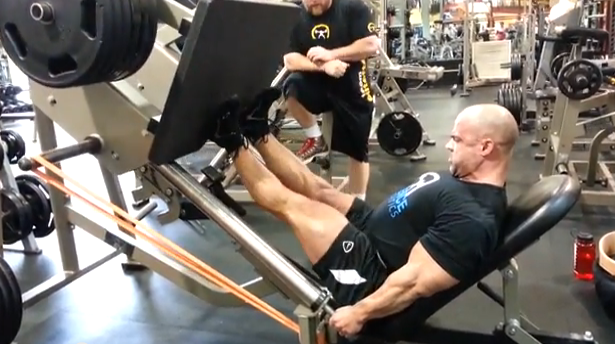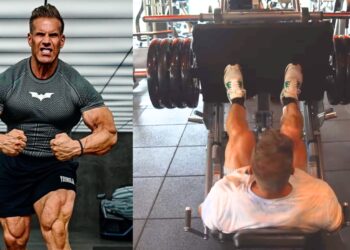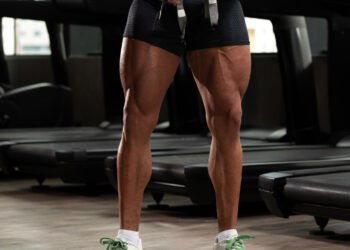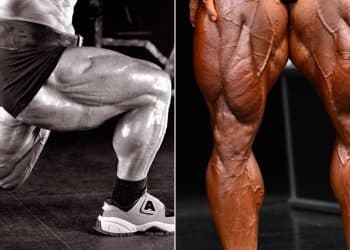Leg presses are a great alternative to squats, and you can use them to build muscle or strength. Learn how to do them properly with our in-depth guide!
The barbell back squat is the undefeated king of leg exercises. In fact, according to one of my old coaches, a workout without squats is barely a workout at all. But, while the squat IS a superb exercise, it’s not the only way to build bigger, stronger legs.
In fact, sometimes, the squat is impractical and may even be inappropriate.
For some exercisers, and in some situations, the leg press could be just as valuable as squats.
In this article, we’re going to reveal all the whys, hows, and whens of leg pressing so you can get the most from this mighty lower body exercise.
Muscles Worked
When determining the value of any exercise, it’s always useful to know what muscles are involved. That way, you can compare similar exercises to decide which one is right for you. The leg press is a compound exercise, which means it involves two or more joints and several muscles, all working together. Leg presses work lots of muscles at the same time.
Level Up Your Fitness: Join our 💪 strong community in Fitness Volt Newsletter. Get daily inspiration, expert-backed workouts, nutrition tips, the latest in strength sports, and the support you need to reach your goals. Subscribe for free!

The main muscles affected during leg presses are:
Quadriceps– known as the quads for short, and located on the front of your thighs, this muscle is responsible for knee joint extension.
Hamstrings– located on the back of your thigh, the hamstrings extend your hip and flex your knee.
Gluteus maximus– also known as the glutes, this large muscle is responsible for hip extension. Located on the back of your hip, your glutes are basically your butt.
Adductors– the adductors are located on the inside of your thighs and are responsible for hip adduction or drawing your thigh in toward the midline of your body. During leg presses, the adductors stop your knees from falling outward.
Abductors– located on the outside of your hips and thighs, the abductors draw your thigh out and away from the midline of your body. During leg presses, the abductors stop your knees from falling inward.
How To Perform Leg Presses
Like any exercise, you’ll get more from leg presses if you do them correctly. Also, improper form could lead to serious injury. After all, with your lower back supported, it’s all too easy to lift huge weights when leg pressing. Doing them wrong, especially with heavy loads, can really mess you up!
How to do:
- Sit on the leg press and slide your butt down and into the bottom of the seat. Place your feet on the footplates, so they are between shoulder and hip-width apart. Position your feet according to your training goal. A narrow stance puts more stress on the quadriceps, while a wider stance spreads the load between all of your lower body muscles more evenly.
- Extend your legs and press the weight up. Flip the safety catches out to the side, so the weight sled is free to move. Grip the support handles and brace your abs.
- Bend your knees and descend as far as your flexibility and knee health allows. Do not let your lower back round. Instead, keep it pressed into the backrest.
- Without bouncing, drive the weight back up, stopping just short of full knee extension.
- That’s one rep – keep going!
Leg Press Benefits
Not sure that the leg press is the right exercise for you? Here are some of the main benefits of this popular exercise.
Back support – during squats, you need to use your core and erector spinae to stabilize your spine. In leg presses, the backrest supports your spine instead. This may be useful if your lower back is tired after something like deadlifts, or you just want to take some pressure off your back.
Easy to learn – the leg press is a relatively simple exercise to perform and is easy to learn. While this is a good exercise for intermediate and advanced lifters, it’s especially useful for beginners.
Increased safety – while things can still go wrong while doing leg presses, the safety bars mean you should be able to catch the weight if you are unable to complete a rep. The same cannot be said of squats unless you are doing them in a power rack.
Versatile – you can use leg presses to build muscle, increase your strength, or improve your muscular endurance. There are also several leg press methods you can use to add variety to your workouts.
Increase lower body training volume safely – most compound leg exercises also involve your lower back. This means that, if you do a lot of different exercises, your lower back may fatigue before your legs. With the added back support, leg presses allow you to keep training your legs even if your lower back is tired.
Post-injury rehab – most leg presses allow you to lift very light weights. Also, you don’t have to worry about balancing the load or stabilizing your spine. This makes them useful for post-injury rehab. Of course, if you are coming back from injury, you should always follow the advice of your doctor or physiotherapist.
Preferentially target different leg muscles – you can emphasize different leg muscles by changing your leg press stance. A narrow stance with your feet low on the platform emphasizes your quads while placing your feet higher on the platform increases glute and hamstring recruitment. A wide stance puts more stress on your adductors.
Important Leg Press Training Tips
Get even more from your leg press workouts with these handy tips!
Keep your feet flat – do not allow your heels to lift off the platform. Doing so increases knee joint stress and will also limit the amount of weight you can lift. Instead, keep your heels down and press through your entire foot, from the ball to the heel. You should be able to wiggle your toes inside your shoes to show that you don’t have too much weight on the front of your feet.
Adjust your reps and the weight to suit your training goal – do sets of 6-12 reps with heavy to moderate weights to build muscle and sets of 3-5 reps with heavy weights to build strength. For endurance, do sets of 13-20 reps with light weights.
Level Up Your Fitness: Join our 💪 strong community in Fitness Volt Newsletter. Get daily inspiration, expert-backed workouts, nutrition tips, the latest in strength sports, and the support you need to reach your goals. Subscribe for free!
Lower the weight under control – lowering the weight too fast makes leg presses less effective and more dangerous. Always lower the weight smoothly and under control. Take 2-4 seconds to bend your legs, and do not bounce the weight up.
Experiment with your foot position to find out what works best for you – differences in leg length, seat angle, and flexibility mean that you’ll need to use trial and error to find the best position for your feet. Try a few different positions until you find the best one for you.
Remember to train your lower back too – leg presses involve very little lower back activation. If leg presses are your main lower body exercise, make sure you also include lower back exercises in your workouts. Romanian deadlifts, reverse hypers, and 45-degree back extensions are all excellent options.
Leg Press Variations
While there is nothing wrong with doing regular leg presses, that doesn’t mean you can’t liven up your workouts with some variations. Here are six different ways to do leg presses.
1. Single leg press
With no weights to balance, it’s all too easy to push harder with one leg than the other during leg presses. Avoid this problem by doing single leg presses. Perform as described above, but place one foot on the floor. Try to use the same weight and do the same number of reps on each leg.
2. Booty band leg press
Leg presses are already a great butt exercise, especially if you place your feet higher on the platform. But, you can make them even more glute-centric by wearing a booty band around your knees. This will force you to push your legs out, increasing glute activation.
3. 1½ rep leg presses
This leg press variation increases time under tension (TUT), which is the time it takes to complete your set. Longer TUTs can be useful for building strength or increasing muscular endurance. To do 1½ reps, extend your legs as normal but then lower the weight halfway down. Extend your legs and then lower the weight all the way down. That’s one rep – keep going!
Alternatively, you can do your extra half rep at the bottom of the movement. Either way, doing 1½ reps make leg presses much more challenging.
4. Leg presses with bands
Using bands increases the resistance at the end of each rep when, usually, tension tends to decrease. Banded leg presses make locking out your knees much harder, which will increase quadriceps recruitment and change the feel of this exercise. The added variety may be useful for triggering new muscle growth and increases in strength.
5. Tempo leg presses
With leg presses, it’s all too easy to sneak an unplanned rest by pausing between reps with your legs straight. This takes tension off your muscles as your bones support the weight. Tempo leg presses are designed to prevent these pauses, keeping the load on your muscles throughout your set.
To do tempo leg presses, stop each rep a few inches below lockout and do not pause at the bottom between reps. Instead, keep pumping your legs like pistons. A few high rep sets with short rests in-between will leave your legs feeling super-pumped!
6. Paused leg presses
With this variation, lift the weight as usual, but then, once you have descended, pause with your knees bent for 2-5 seconds before pushing it up again. Do not relax or rest your knees on your chest. Instead, maintain muscle tension. Drive the weight back up and repeat. Pausing between reps eliminates momentum, which will make each rep harder than usual.
Common Mistakes
Leg presses are a relatively straightforward exercise, but that doesn’t mean they can’t be done incorrectly. Avoid these common mistakes so that you can enjoy all of the benefits and none of the drawbacks of this popular exercise.
1. Half repping
Leg presses allow you to lift some serious weight. But, if you use so much weight that you cannot use a decent range of motion, you won’t build muscle, get stronger, or gain any other benefits from this exercise. Make sure you can lift and lower your weight through a full range of motion. No half (or quarter) repping, please!
2. Letting your lower back round
While leg press machines provide plenty of back support, it’s still possible to round your back. If you lower the weight too far, some of that extra movement may come from your lumbar spine, rather than your hips and knees. Monitor your lower back and, if you feel it starting to round, adjust your range of motion accordingly. Rounding your back is a great way to injure it, especially if you are lifting heavy weights.
3. Ignoring the importance of neck position
Your neck should be relaxed during leg presses. If you lift your head, you are more likely to round your lower back too. Keep your head on the backrest when leg pressing. If this is uncomfortable, rest your head on a folded towel or yoga block.
4. Letting your knees drop in or out
Your knees are a hinge joint, and like the hinges on a door, can open or close. They are not designed to be twisted. Avoid letting your knees drop in or out during leg presses as this increases joint stress and could lead to injury.
5. Making it all about the weight
Leg presses allow you to lift a lot of weight, but the more weight you lift, the more dangerous this exercise becomes. Instead of just piling on the plates, look for less stressful ways to make leg presses more challenging, such as slower reps, 1½ reps, and taking shorter breaks between sets. Your knees will love you for it!
6. Placing your feet too high or too low on the footplate
While you should experiment with different foot positions, you should also avoid extremes. Having your feet too low will create a very acute knee angle that could cause joint problems. Having your feet too could lead to a rounded lower back. Move your feet to work different parts of your legs, but don’t risk injury by going too high or too low.
7. Wearing knee wraps
Powerlifters wear knee wraps to help them lift heavier weights. They provide bounce out of the bottom of squats. There are no prizes for the heaviest leg press, so wearing knee wraps for leg presses doesn’t make a lot of sense. After all, the aim of the exercise is to overload your muscles, and not see how much weight you can lift. If you need extra knee support for leg presses, wear knee sleeves and not knee wraps.
Wrapping Up
The leg press is one of those exercises that are easy to take for granted. After all, they are much simpler than squats and easier to learn than deadlifts. But, they’re still a serious exercise and should not be underestimated – either in terms of potential rewards or their potential for causing injury.
Some trainers hate on leg presses, saying that they are non-functional. However, every exercise has a function, and the leg press is not a bad exercise just because it involves using a machine.
Use but don’t abuse leg presses. They are a beneficial lower body exercise that can help you reach your training goals.

